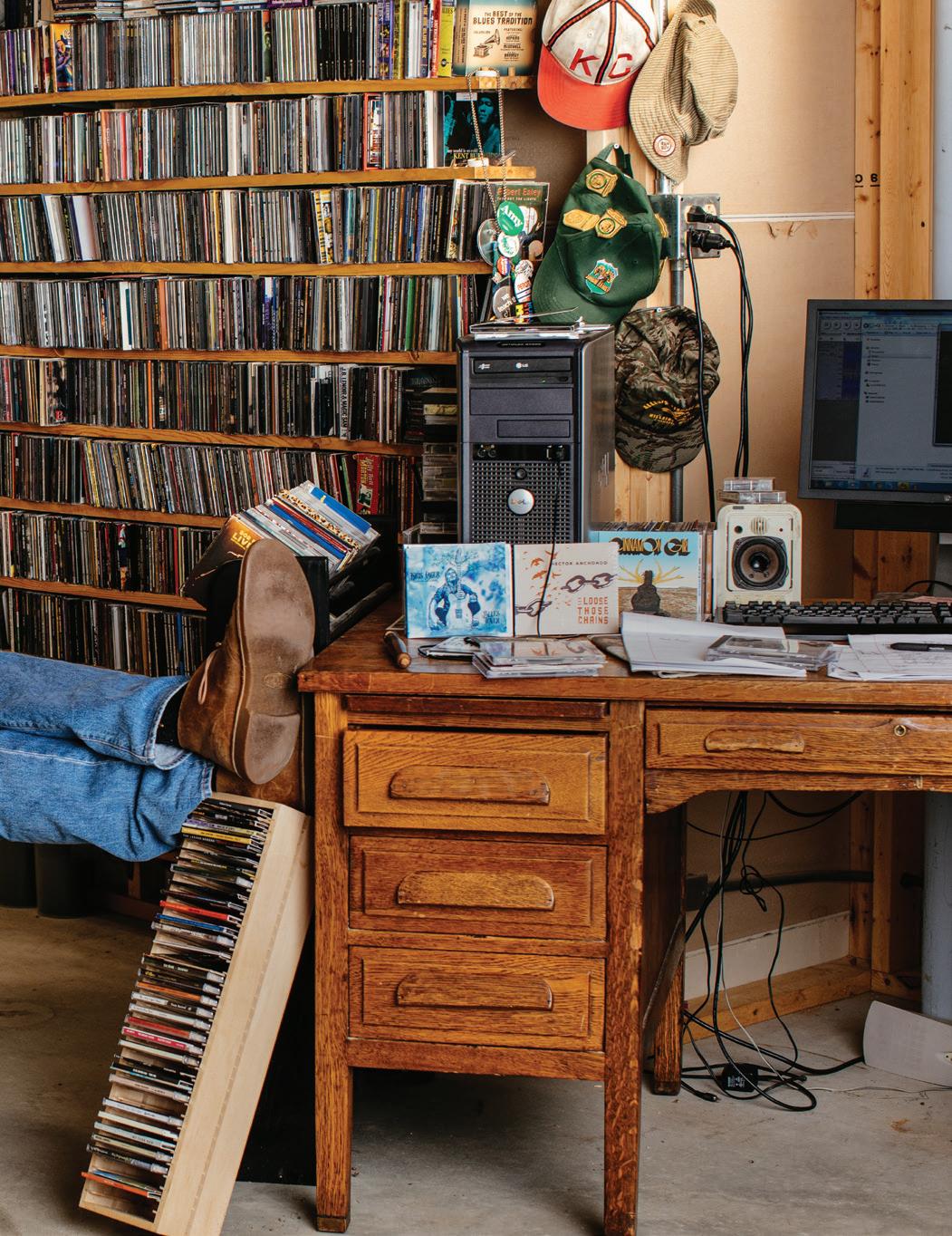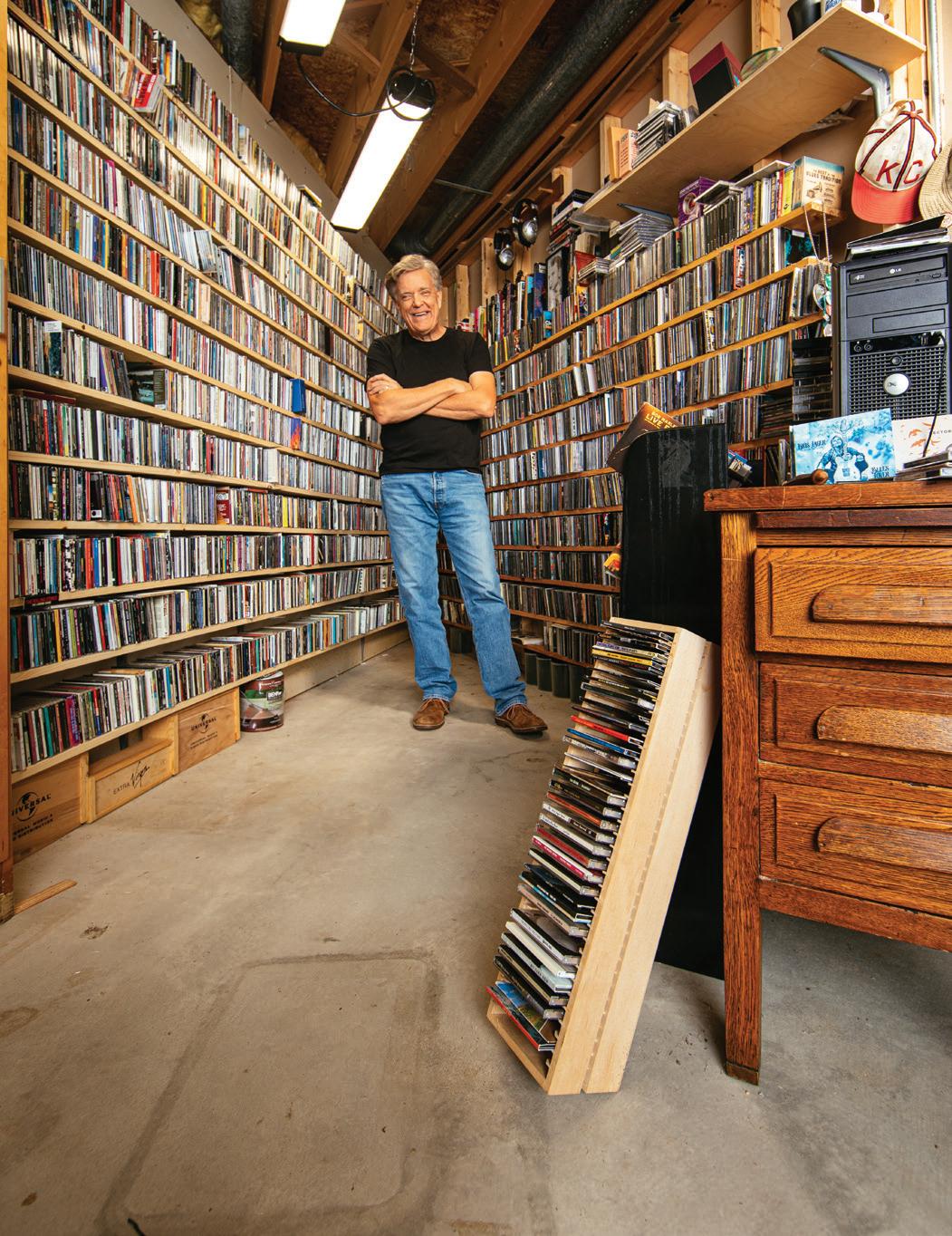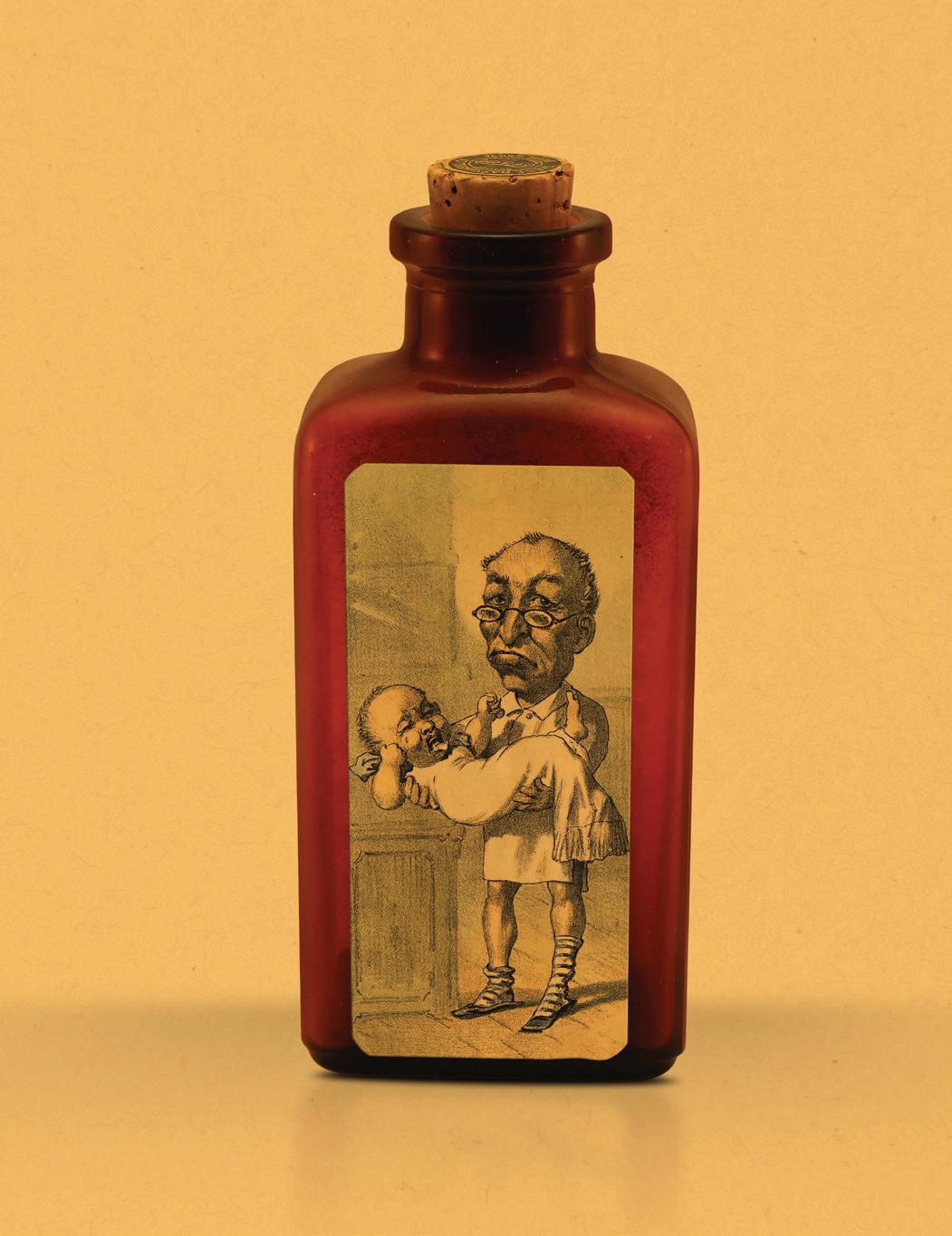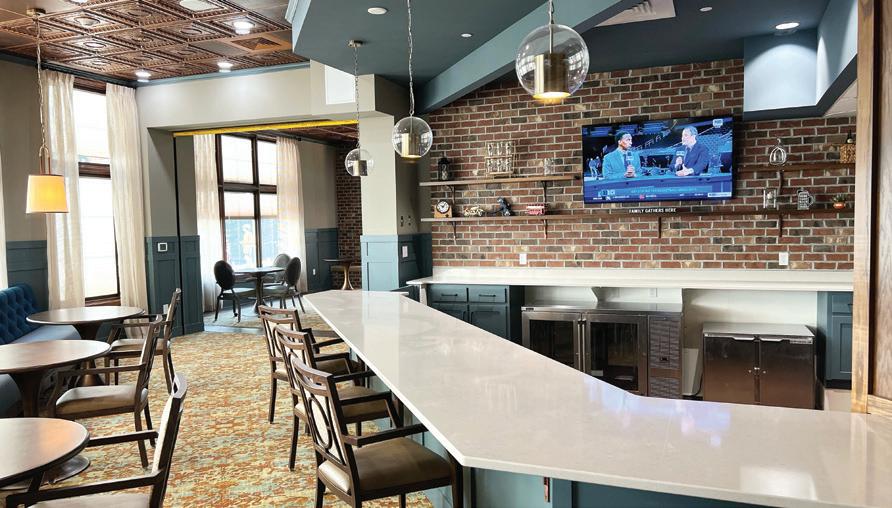
11 minute read
Nostalgia
60+ Profile STORY BY DWAIN HEBDA PHOTOGRAPHY BY BILL SITZMANN DESIGN BY DEREK JOY

ick Galusha has packed a lot into 61 years—myriad ventures and passions that include college professor, radio show host, businessman, would-be Douglas County Register of Deeds, newspaper columnist, and general, genial community rabble-rouser.
He has done so much in so many fields, that at first glance it’s hard to spot the thread that binds them all. Music comes closest.
Galusha has known music as art, livelihood, and community, defining as it does our social, political, and generational story. These themes and more he has debated and discussed both in the college classroom and, most notably, as host of Pacific Street Blues & Americana, a fixture on KIWR 89.7 FM, The River, for three decades.
“I began dabbling in radio when I went to the University of Wyoming very briefly in the late ’70s and then came back to UNO and got into jazz and classical music,” he said. “[Jazz] was not really my thing at the time, but I wanted to be in radio, and that was the doorway to get in.”
He continued, “Then, probably in the late ’80s, there was a new radio station, KKVU, which was soft jazz. I went in and talked to the music director and he had a bunch of tapes on his desk of nationally syndicated blues programs. I’m like, ‘I can do that for you.’ He said ‘OK.’” Galusha’s pitch, lowkey though it was, was not mere bravado. His musical knowledge was honed and curated during nearly a quarter-century working at Homer’s, the legendary Omaha record store at which he would rise from college-student clerk to CEO.
“As a kid in the ’60s and really, the early ’70s, my sister would take us down to the Old Market and the original Homer’s Music store. It was just a land of enchantment,” he said. “Homer’s had a store in Westroads Mall that I would go and work in… for free, because I wanted to work there so bad.”
Working Homer’s counter in college was Galusha’s bliss, and when he rejoined the company in the late 1980s after a brief period away, he thought it would be more of the same. It wasn’t, but it taught him other sides of the music business that would inform his later endeavors.
“At that time, the guy that was running the organization was stepping out,” Galusha said. “He’d been there since the founding and he was going to move on to do other things. Eventually that gave me the opportunity to step into the lead role.”
“Things were pretty loose,” he continued. “It wasn’t a corporate environment by any stretch of the imagination. It was kind of a mom-and-pop operation and we were developing some guidelines to be a better-run organization. There were growing moments and there were painful moments, and I loved it. But running the organization was not as much fun as running the counter.” With Pacific Street Blues, Galusha got the chance to return to his favorite part of the music business, which is educating others on various genres, turning people on to new artists, and connecting the dots.
“I can play straight blues for three hours and I’d be quite happy, and the eight people that listened I’m sure would really enjoy it,” he said with a laugh. “The challenge is, how do I weave together a show that brings in a larger audience?”
That’s where Galusha’s knowledge of music comes in. “I’ll focus on the blues roots of Aerosmith, for instance. We’ll play an Aerosmith track everybody knows, but not the hits. They cover Bull Moose Jackson’s “Ten Inch Record”; they cover Rufus Thomas’ “Walking the Dog.” They cover Sonny Boy Williamson’s “Eyesight to the Blind.”
“He’s got such an intense background in the blues music, going back to Muddy Waters and some of the originators of the blues,” said Bill Bone, a longtime listener and friend. “He then incorporates that into the more modern music and how the old ones influenced the new ones. He’s introduced me to some things, Johnny Winter for one.”
Galusha counterbalances his expertise in classic rock and roots music with today’s influences, something he’s exposed to through his teaching gig at Bellevue University. His musical sphere seeps into his lectures and their tracks reverberate back to him. In many instances, he likes what he hears. “I think modern music is much more overt than it was for a very long time,” he said. “When we look at the political messaging in popular music, there was a significant lull in the ’80s and ’90s. But when I hear music the students are listening to, it’s highly politicized. I would describe it as very socially aware, very socially engaged while they’re getting that beat into their head.”
Galusha uses the same tactics with students as he does with listeners to drive home the point that the messages of today were written yesterday in the hopes of a better tomorrow. And if there’s a running theme for his radio show—which, with the addition of a podcast, shows no signs of slowing down—he wants that to be it.
“Someone once told me, ‘You’re a teacher. That’s all you do,’” he said. “I enjoy building that bridge of using classic rock, tying it back to the blues, and helping people begin to build those connections. And I love doing that. That’s the art of what I’m trying to accomplish, to make it entertaining and yet informative and challenging.”
Visit 897theriver.com for more information.
We don’t need help to burp, and our lower esophageal sphincter works much better than an infant’s. -Dr. Amber Tyler

Quack Medicine with Staying Power
Silly, and Dangerous, Medical Myths from the Past
60+ nostalgia // story by Tamsen Butler // photography provided // design by Derek Joy
ocaine being used as a cure for depression; tobacco for constipation; and lobotomies for mental illness. Medical science has boasted some bizarre treatments and theories in years past, but some medical myths have staying power thanks to grandparents passing down “medical knowledge” that are accepted as fact in families.
Nurse practitioner Amy Wallingford said there are some medical myths that she encounters frequently with patients that she has to debunk, much to the patients’ surprise.
Putting butter on a burn. “This can actually hold the heat and it creates a good environment for bacteria to grow,” Wallingford said. This myth can be traced back to a battlefield medicine manual in the 19th century, but going even further back to ancient Egypt, mud and excrement were the remedies of choice for burns and injuries.
Using whiskey for teething babies.
Though it’s not known when this medical advice first came to be, it is known that doctors gave this advice to parents in the mid-1800s. It was more about getting the baby to sleep and less about relieving gum pain. Consider the ratio of a baby to an adult and it becomes clear how even a little alcohol rubbed on a baby’s gums can translate into a dangerous dosage.
Cold/wet weather makes you sick. The cold isn’t directly responsible for getting people sick, although some viruses thrive in lower temperatures and cold air can indeed lower the immune system’s ability to fight off infections. Spending more time indoors during cold weather means more time spent around other people and therefore more opportunities to encounter germs. But cold weather alone won’t make you sick; that’s the work of a virus or bacteria. Sugar makes kids hyper. Medical research shows no link between sugar consumption and hyperactivity with neurotypical children. Sugar is typically present in social situations in which kids are expected to be high-energy, such as cake at a birthday party, but in these instances it’s probably the child’s excitement causing the hyperactive behavior as opposed to the sugar consumed.
You need to stay awake if you’ve had
a concussion. It was once assumed that allowing a person with a concussion to fall asleep might lull the person into a coma or death, but this isn’t necessarily true. In fact, sleep is one of the most powerful recovery methods for people with brain injuries within the first few days of the injury. It’s important to note that sleep isn’t advised in concussed patients until they receive medical care if they’re unable to carry on a conversation or walk, or they have dilated pupils.

Chewing gum stays in your stomach
for seven years. While it’s true that your body won’t digest chewing gum after it’s swallowed, the body does still move the gum through the digestive system safely. The gum winds up in stool, fairly intact, and takes a few days to work its way through the body—but not seven years.
You should wait an hour after eating
before you go swimming. This myth originally stemmed from the idea that the stomach pulled so many bodily resources to digest food that the arms and legs wouldn’t be able to function properly while swimming, leading to drowning. While it’s true that some foods at certain quantities might cause stomach discomfort if you exercise right after eating them, it’s unlikely to lead to anything more than uncomfortable cramps.
Cracking your knuckles leads to
arthritis. Cracking knuckles has not been proven to be detrimental nor beneficial to joints, but there is also no research to support the idea that cracking knuckles will eventually lead to arthritis. Some knuckle crackers may experience temporary inflammation in their fingers, but actual injuries from cracking knuckles are rare.
Wandering uteruses and hysteria, oh
my! “This is straight up funny,” said Wallingford, explaining that medical professionals once believed in “wandering uteruses.” Depending on where the uterus wandered within a woman’s body, physicians could pinpoint the reason for her various maladies. Of course, in modern society, it’s well known that the uterus doesn’t actually travel throughout the body mischievously.
Is it possible that there are medical practices accepted today as fact that will someday be regarded as myth? Consider this advice from Dr. Amber Tyler:
“Babies don’t need to be burped,” said Dr. Tyler. “At some unknown point a long time ago, someone was probably trying to soothe a fussy baby by patting them on the back and the baby burped, and they decided babies must need help to burp and told all their friends. So now everyone burps babies. Physiologically that doesn’t make much sense. We don’t need help to burp, and our lower esophageal sphincter [opens easily as] an infant. With their laxer lower esophageal sphincter it should actually be easier for them to burp than it is for adults.”
“There have now actually been studies done that show that the only significant difference between babies who were burped and babies who weren’t is that burped babies spit up more,” explained Dr. Tyler, shattering a medical myth long-held by parents in Western culture.

Parsons House on Eagle Run
A PLACE TO CALL HOME N
estled in the quiet neighborhood of Champions Run, directly across the street from St. Vincent de Paul Catholic Church, Parsons House is Omaha’s leading assisted living and memory care facility. The facility is a family-owned property with long ties to the Omaha community. Kim and Andrew Reeves believe the primary focus should be entirely on compassion, quality care, and living life to the fullest. As a single-owned property, there are no multi-levels of management to navigate.
Parsons House’s professional staff is at the core of their residents’ experience. The staff’s attentiveness and availability is evidenced by the interaction with the residents—the same residents with whom the staff knows by first name, listens to their life experiences, laughs with, and shares a hug. The staff understands that above all of the services they provide, when they are at work, they are in someone’s home—and home is where family and friends belong.
Parsons House is uniquely designed to create a warm and inviting home atmosphere. The grand dining room, aptly named “Seasons,” overlooks the scenic landscape of Champions Run Golf Course. The Reeves and their staff take pride in the trained chef, who offers homemade meals created from fresh ingredients that rotate with the season. Directly adjacent is Champions Tavern, where residents and family may gather to enjoy a cocktail and watch Nebraska football together. The French Press Bistro greets residents and visitors and offers them a light breakfast or lunch and custom coffee. Other amenities include Reflections—a salon and spa, children’s playground, wellness gym and courtyard, chapel, and great room. Externally, the secured, landscaped grounds are among the best and largest in the city.
Parsons House features a specially designated memory care division, known as The Cottages, that addresses the unique and specific needs for a loved one suffering from Alzheimer’s or other memory disorders. From the generous use of natural light, pleasing colors, and familiar furnishings, this division instills a sense of comfort, promotes self-esteem, and nurtures independence, with the full spectrum of care given to all residents.
The staff at Parsons House invite interested persons, and their families, to visit them in order to discuss each potential resident’s unique situation, and leave with the confidence that their loved one’s needs will be met. Parson’s House believes potential residents and their families will agree that this is the best care facility in Omaha..
14325 Eagle Run Drive Omaha, NE 68164 402-498-9554 parsonshouseseniorliving.com









